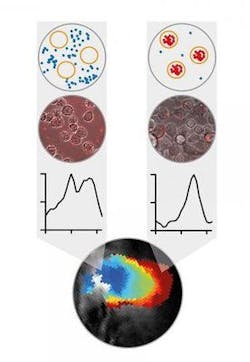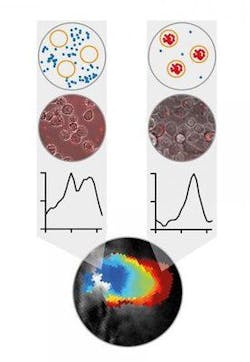Optoacoustic imaging technique visualizes tumor heterogeneity
A team of scientists from Helmholtz Zentrum München, the Jülich Research Center, the Technical University of Munich, and Heinrich Heine University Düsseldorf (all in Germany) has shown that harmless purple bacteria of the genus Rhodobacter are capable of visualizing aspects of tumor heterogeneity in cancerous tumors. With the aid of optoacoustic imaging, the researchers used these microorganisms to visualize cells of the immune system known as macrophages, which also play a role in tumor development.
Many cancers form solid tumors that reveal major differences at the cellular and molecular level. One of these concerns the localization and activity of macrophages. Although these cells are essential for a healthy immune system, they also play a key role in tumor development. With the aid of photosynthetic bacteria, new optoacoustic techniques, which indicate where such macrophages are present and active, have now been developed.
"We were able to demonstrate that bacteria of the genus Rhodobacter, which are harmless to humans, are suitable as indirect markers of macrophage presence and activity," says Dr. Andre C. Stiel, head of the Cell Engineering Group at the Institute of Biological and Medical Imaging (IBMI) at Helmholtz Zentrum München. Rhodobacter bacteria produce large quantities of the photosynthetic pigment bacteriochlorophyll a. This pigment enabled the researchers to detect bacteria in a tumor by means of multispectral optoacoustic tomography(MSOT).
Change of optoacoustic signals of purple bacteria located outside (blue) and inside (red) of macrophages visualized via schematic (first row), microscopic (second row) and MSOT analysis (bottom). The change of MSOT spectra (third row) can be used to differentiate between Rhodobacter cells located inside and outside of macrophages and hence macrophage localization and activity. (Image credit: ©Helmholtz Zentrum München)
Macrophages engulf bacteria as part of their natural scavenging activity, which is known as phagocytosis. This alters the surroundings of the bacteria, their absorption of electromagnetic radiation and, as a result, also the optoacoustic signal. Rhodobacter bacteria thus act like sensors for scientists, providing them with information about the presence and activity of macrophages.
Related: Multispectral method is noninvasive for imaging tissue oxygenation
"In further steps, these bacteria will enable novel approaches to noninvasive technologies and so open up entirely new possibilities for innovative diagnostic and therapeutic procedures," adds Dr. Thomas Drepper, who heads the Bacterial Photobiotechnology Group at Heinrich Heine University Düsseldorf.
In the future, bacteria may be able to reveal the location of a tumor and also detect increased macrophage activity. Depending on their localization, the macrophages could provide information about unwelcome inflammations or the desired response to immunotherapies, and could ultimately be used to improve treatment strategies.
Full details of the work appear in the journal Nature Communications.

